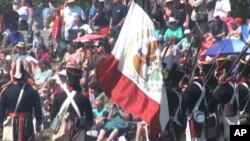One of the most consequential battles in North American history occurred 175 years ago on a field just east of current-day Houston, Texas. In the battle of San Jacinto, on April 21, 1836, a ragtag Texas rebel army of about 900 men defeated some 1,500 Mexican soldiers and won independence. This led to the Mexican-American War in which the United States acquired California and other southwestern states - leading to disputes over the expansion of slavery and ultimately to the U.S. Civil War. The shots fired in 1836 reverberate across the southwestern United States today.
Telling the story through re-enactment takes longer than the battle itself. In one of the biggest upsets in American history, the small Texas rebel force led by General Sam Houston swept over the Mexican camp in about 18 minutes.
The Mexicans had easily won every battle before this one and perhaps were undermined by their own self confidence.
After being captured, Mexican leader General Antonio Lopez de Santa Anna ordered his troops to leave Texas. He signed a document giving the territory its independence, something officials in Mexico said he had no right to do.
At this re-enactment, staged on the ground where it happened, near the San Jacinto monument, Hilario de la Pena, a Mexican-American from San Antonio, Texas, played the role of Santa Anna, who was sent to Texas to restore order.
De La Pena says he sympathizes with Mexico, but that he favors the side that won.
"Am I ambivalent? No. I am glad that Texas ultimately won. I was born and raised in San Antonio and so I am glad the way things turned out," said De La Pena.
Many Mexicans still resent what they view as a land grab by the United States. But some of the rebels, like the famed Juan Seguin, were Mexicans. And De La Pena says their culture endures.
"You see the Spanish culture still ever, ever present in the entire southwest," noted De La Pena. "And now Hispanic culture is throughout the country of the United States."
Hispanics are the fastest growing ethnic group in the United States and are likely to become the dominant culture here in Texas and in other southwestern states in the decades ahead.
Elizabeth Elizalde came to the re-enactment with her son Edgar.
"I am a true Texan at heart; I was born here, so we came to cheer for the Texan side," Elizalde said. "But my parents, who are from Mexico, kind of tell history a little differently than what we learn here."
But she says Texas was separated from Mexico City by more than 1,000 kilometers of mountains and deserts. So even if Santa Anna had won this battle, he would not have been able to maintain control of Texas.
"Maybe there would have been a different battle and they would have lost because Mexico was so far away from this land that they were not able to control it well," Elizalde added.
On the other side of the monument, in the area where most of the heavy fighting happened 175 years ago, High School teacher Scott Griffin shows a group of students around.
He grew up in this area and has studied the history all of his life. He says he understands that some people gained and others lost here.
"From the Mexican standpoint today, if I put myself in their shoes, it would be hard to argue that it was not lost territory, something that was once theirs that was lost," said Griffin.
But Griffin notes that Mexico had very few settlers in what is now the U.S. southwest - including Texas - where warriors of the Apache, Comanche and other American Indian tribes held sway.
"Mexico could not get anyone to leave Mexico and come and live in this part of Texas during that time," Griffin explained. "And that is why Santa Anna opened up immigration to [what is now] the United States."
Still some Hispanics in Texas trace their lineage back to that time and want to see all perspectives represented at the reenactment.
Jessica Torres, 16, wore a Mexico tee shirt for the event.
"It is pretty cool to see the Texas point of view and it would also be cool to see the Mexicans' point of view. But I wore the shirt because it matches my pants," Torres said.
So, in the years ahead, the story of this battle will be told over and over again, with a new generation of Texans, made up of many races and cultures reexamining history.
Whatever perspectives might emerge, the fact is that because of this battle and the Mexican-American War that followed, the United States doubled in size, became a bi-coastal nation and an important power on the world stage. And it all started here.










